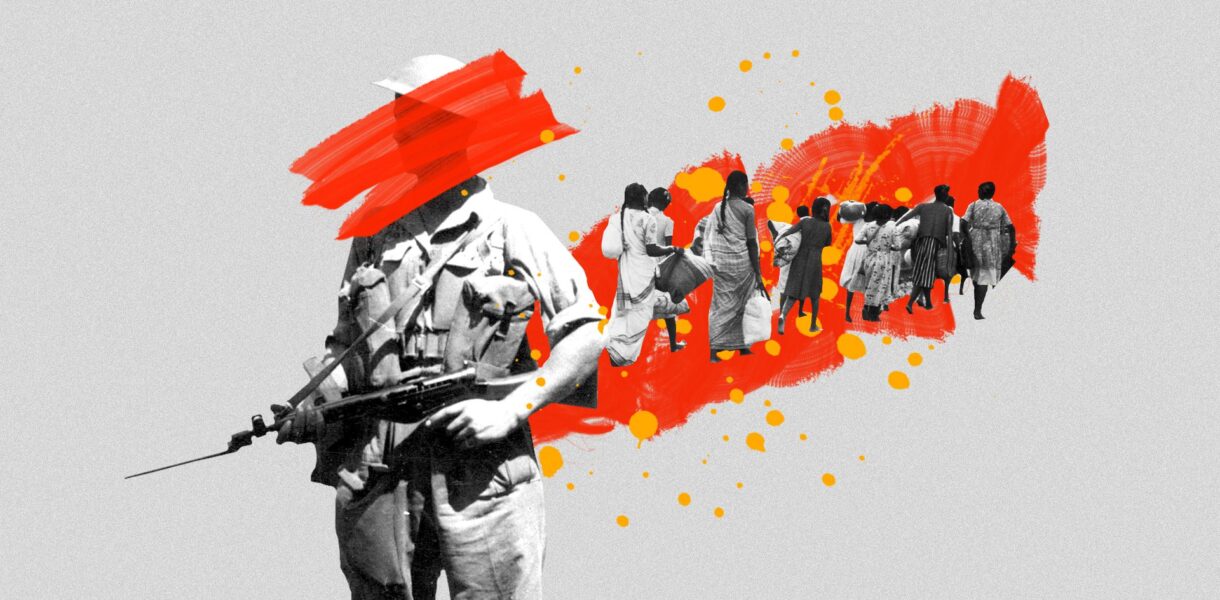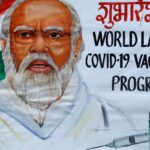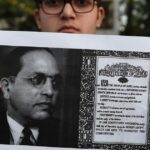

Introduction
Broadly speaking human rights may be regarded as those fundamental and inalienable rights which are essential to life as a human being. Human rights are the rights which are possessed by every human being simply because of his/her being a human being, irrespective of his/her nationality, race, religion, sex, place of birth, descent etc. Characteristics of Human rights are that they are Inalienable, Universal, Dynamic, essential and necessary, connected with human dignity. It was after World War II, that human rights were pronounced officially as an international concern, leading to the adoption of the Universal Declaration of Human Rights (UDHR) in 1948.
Among many dimensions of International Humanitarian law (hereinafter IHL), one fundamental issue remains to be the “civilian immunity‟, that is, the protection of certain people from the harm of wars. IHL covers, thus, three significant areas, firstly, the protection of those who do not take part or are no longer taking part in the war; secondly, restriction on the means of warfares like weapons; and thirdly, permissible tactics.
Accordingly, The International Committee of the Red Cross recognizes two branches in IHL, firstly, the “law of Geneva‟, which seeks to protect the victims of armed conflict; and secondly, the “law of the Hague‟ which establishes rights and obligations of the belligerents in the conduct of hostilities.1
INTERNATIONAL LAWS IN ARMED CONFLICT & HUMAN RIGHT
International humanitarian law is the law that regulates the conduct of armed conflict. International Humanitarian law is a set of rules which seek, for Humanitarian reasons, to limit the effects of armed conflicts. International Humanitarian law is also known as the law of war or the law of armed conflict. It is stated in the Holy Quran – “Non Combatants who did not take part in fighting such as children, women, monks , hermits, the aged, blind and insane were not to be molested…..” “Do not mutilate, don’t kill little children or old or women. Don’t cut off the heads of palm trees or burn them, do not cut down fruit trees”- (Abu Bakr). Furthermore, Massacre of civilians have long history from the massacrees of the kalingas by Ashoka, the massacres of some 100,000 Hindus by the muslim troops of timur, the crusader massacre of Jews and Muslims in the siege Jerusalem (1099).
Historical development of International Humanitarian law
When Henry Durant visited the wounded soldiers after the battle of Salferino, he was shocked by the lack of facilities, personnel and medical help needed to the soldiers. As a result he published his book Memoir of the Salferiono, in 1862 on the horrors of war resulting in the Geneva Convention for the amelioration of the condition of the wounded in Times of war 1864.
Geneva Convention of 1949
This conference was held in Stockholm (23 August – 30 August 1948). During WWII shocking crimes were committed against humanity. At the end of the war atomic bombs were dropped over Hiroshima and Nagasaki by the US Air force. Geneva convention negotiates on the aftermath of the second war (1939-1949) which updates the terms of the first three treaties // (1864, 1906, 1929) and adds a fourth treaty.
Prisoner of war convention
The “Third convention” or “POW Convention” regulates all the smallest details of the treatment of prisoners of war.2 When captured, prisoners of war are bound to give their name, military rank, date of birth and serial number. They cannot be compelled, in any circumstances, to provide further information.3 Also, under the Third convention, torture and other severe ill- treatment are considered war crimes.4 Prisoners are entitled, immediately upon capture, to complete what is called a capture card,5 which is then sent, via the ICTRC central Tracing agency, to the official information bureau in the prisoner’s own country.6 Further, the central Tracing agency has the task to inform the relatives of the prisoners about his whereabouts so that links with home and family can be rapidly re-established. Prisoners of war are entitled to correspond with their relatives (letters and words being exchanged usually through the ICRC ( Central Tracking Agency)7. They would also receive aid in the form of individual parcels.8 Measures of reprisal against POW are forbidden without exceptions.9 A very important group of provisions in the Third Convention is dealing with the repatriation of prisoners of war.10
Convention of armed conflict
The provision of the four geneva convention of IHL, 1949 and its additional protocol of 1977 specifically provides a legal mechanism to protect certain categories of people. These categories include civilians including women and children, civilians on the territory of the enemy, civilians interness, civilians in occupied territories, wounded, shipwrecked members of the armed forces,prisoners of war, refugees and displaced persons and missing persons. It is pertinent to mention that civilians have a general right to protection against the effects of hostilities but if they participate in armed conflict, the protection which are provided under IHL will not be extended to them.
IMPLEMENTATION OF INTERNATIONAL LAWS WITH RESPECT TO INDIA & PALESTINE
The simultaneous applicability of both laws means multiple institutions under both IHL and human rights regimes will need to take under consideration the other’s laws and to act accordingly. As an example, among the human rights treaty bodies, the Committee against Torture is handling a sort of conduct prohibited under both IHL and human rights law. as an example, within the cases of extraterritorial enforcement which incorporates action by defense force against persons or entities in another state that engage in international crimes. An action for self-defence might not necessarily be an armed conflict against another state. An example are often the utilization of force by the Colombian army against members of the Revolutionary soldiers of Colombia in Ecuador. Another dilemma may arise during a situation when a state may attempt to bring law and order within the occupied territory, it sometimes seems hard to characterize it as an armed conflict.
PALESTINE
Israel is at risk of breach jus in bello in pursuit of its national interest and national security. Israel is unable to differentiate “non-combatants” from “combatants.” Israel also often ignores “protected property” from “military objectives.” Israel targets Palestinian civilians, their land, residences, houses, buildings, schools, historical monuments, hospitals, medical transports, water sources, water infrastructure, and olive cultivation in their war against Palestinians, which are deliberate breaches over jus in bello as coded in the Geneva Conventions. Israel signed the Geneva Conventions in December 1949 and ratified them in 1951. Article 1 of every convention states that the sponsors of the convention will “respect and ensure respect for the conventions altogether circumstances”.
Further, the thought of armed conflict becomes more complex within the case of internal conflicts. Article 3 common to the 1949 Geneva Conventions refers to the armed conflicts not of an international character, implying that any armed conflict that is not covered by Common Article 2, is covered by Article 3. However, at an equivalent time, it’s been observed that Article 3 was intended to use to internal conflicts. Hence, the question of what constitutes11 an armed conflict is complex.
Role of United Nations
The seventh and the last principle of the United Nations states that nothing contained in the present charter shall authorize the United Nations to intervene in matters which are essentially within the domestic jurisdiction of any state. However, the present situation of human rights violation in Palestine is not a domestic issue and the United Nations have the power to intervene. The United Nations can impose sanctions on any member country for human rights violations under Article 2(4) of the UN charter. However, due to the brittle political regime marked by the overall pandemic has left a little space for making such sanctions at this time.
Palestine occupied territory of Israel
According to Article 42 of The Hague Regulations; a ‘Territory is taken into account occupied when it’s actually placed under the authority of the hostile army. The occupation applies only to the territory where such authority is established, and in a position to assert itself.’ In 1967, the Israeli army occupied the Palestinian Territories and took effective control over it. Since then, the West Bank , including East Jerusalem, and therefore the Gaza Strip , constitute Occupied12 Territories; whereas its Palestinian13 citizens are considered ‘Protected Persons’ under Article 4 of the Fourth Geneva Convention relative to the Protection of Civilian Persons in Time of War (Fourth Geneva Convention of 12 August 1949).
Is Palestine a state which is granted state recognition?
In 1948 Israel declared himself to be a independent state creating statehood by declaratory theory of recognition. Hall even advocates that the new state is formed independent of the recognition by the other states. On 11 May 1949 Israel became the part of United Nations and hence was granted collective recognition by all member states individually. However, Palestine is not granted state recognition by various countries of the world. Further, Palestine is also a member of the United Nations and is also bestowed collective recognition but has status of non member state. Palestine now has a defacto recognition but still is not granted dejure recognition.
Violation of Fourth Geneva Convention by Israel
Israel ratified the Fourth Geneva Convention in 1951. Furthermore, Article 35 of Israeli Military Proclamation No. 3 ordered that Israeli military courts and officers were bound by the provisions of the conventions; however, on the October 22, 1967, the proclamation was amended and Article 35 was canceled by Military Order No.144. Israel since that date has insisted that the convention isn’t applicable to the Occupied Palestinian Territories (OPT).14 Israel claims that its presence within the OPT is as an ‘Administrator’, therein way holding its authorities completely unaccountable to the Fourth Geneva Convention, for it refuses to acknowledge the Convention’s de jure application to any of the Occupied Territories. However, Israel said it’ll comply de facto with the Convention’s15 humanitarian provisions in administering the West Bank and therefore the Gaza Strip , but the applicable provisions haven’t been specified. Israel argues that its ‘Occupation’ is just a reaction to aggression or a way of self-defense, but it’s actually an expression of a pro-active policy of de facto annexation that began immediately after the 1967- war. However, the legal and international opinions enforce the applicability of the Fourth Geneva Conventions to the Palestinian Territories as an ‘Occupied Land’. The UNSC Resolution 799, on December 18, 1992 clearly Reaffirms the applicability of the Fourth Geneva Convention of 12 August 1949 to all or any the Palestinian territories occupied by Israel since 1967, including Jerusalem, and affirms that deportation of civilians constitutes a violation of its obligations under the Convention. Moreover, since the start of its occupation of the Palestinian Territories in 1967, Israel’s military authorities have issued over many military orders to vary the pre-existing laws, and to effectively extend military jurisdiction over the OPT Almost every element of Israel’s occupation of the Palestinian Territories violates a provision of the Fourth Geneva Convention. Many of Israel’s violations are grave breaches of the Convention and are considered ‘War Crimes’ under law16 of nations.
Can jurisdiction of the ICJ be invoked in cases of human rights violations in Palestine?
In its statement on the appliance of human rights in situations of armed conflict, the 1996 Advisory opinion on the legality of the Threat or Use of Nuclear Weapons, the International Court of Justice (ICJ) made three announcements therein respect, firstly, human rights laws are applicable even during armed conflicts. Secondly, it’s applicable in situations of conflict, subject only to derogation. Third, when both IHL and human rights law are applicable, IHL is that the lex specialis, meaning thereby, as an example, the right of to not be arbitrarily bereft of one’s life applied in hostilities, however, what constituted an arbitrary deprivation of life must be construed by the applicable lex specialis, that is the law applicable in armed conflict. Similarly, the ICJ emphasized in the case of the Construction of the Wall in the Occupied Palestinian Territory and DRC v. Uganda, human rights treaties continue to apply in wartime. This settlement by the ICJ has been generally deemed to settle the issue of the interplay between IHL and human rights law. In other words, when human rights law and IHL are in conflict, the latter will prevail, since it specifically deals with armed conflict. However, the contradictions are inevitable, when these laws are applied to the same facts since they represent different circumstances for which they were formulated. Moreover, some scholars point out the use of the phrase lex specialis is itself prone to perusal, since not every situation may be judged on the basis of IHL only.
The International court of justice is the principal organ of the United Nations. It has two main jurisdictions. They are contentious jurisdiction and advisory jurisdiction. Further the contentious jurisdiction is of two types voluntary or original jurisdiction and compulsory or optional jurisdiction. As Israel has not ratified the optional clause as enumerated in Article 36 (1) of the International court of Justice Charter and therefore the ICJ cannot exercise its compulsory jurisdiction. Furthermore the Calvo Doctrine suggests minimum intervention. The calvo doctrine is the foreign policy doctrine which proposes to prohibit diplomatic protection or armed intervention before local resources are exhausted.
KASHMIR
International human rights law prohibits the arbitrary deprivation of life under any circumstances. The govt. of India is also a part of the International Covenant on Civil and Political Rights (ICCPR). Article 6 of the ICCPR expressly prohibits derogation from the right to life. Thus, even during times of emergency, “No one shall be arbitrarily deprived of his life.”17
The ICCPR also prohibits torture and other kinds of cruel, inhuman and degrading treatment. Articles 4 and 7 of the ICCPR explicitly ban torture, even in times of national emergency or when the security of the state is threatened.18
The Indian occupation forces have persistently violated every fundamental right of the Kashmiri people and employed every tool of oppression to further consolidate their illegal stranglehold. U.N. General Assembly Resolution 2200 A (XXI) of 16 December 1966. India became a signatory on April 10, 1979.
There are repeated instances of extrajudicial killings during fake “encounters,” “cordon-and-search” operations, the destruction of property, and thus the indiscriminate use of pellet guns and live ammunition against unarmed, peaceful protesters. The scrapping of article 370 and subsequent annexation and illegal occupation of the state of Jammu and Kashmir by India has brought the seven-decades-old Kashmir19 issue, a serious explanation for friction between two nuclear states India and Pakistan into international limelight. Before this constitutional catastrophe, the state had special status, separate laws, constitution, and flag. This special status has been revoked in utter contravention of UNSC resolutions and International Law.
The Indian army, Special Task Force, Border force, and state-sponsored paramilitary groups and village defence committees-the principal government forces operating in Jammu and Kashmir- have systematically violated these fundamental norms of international human rights law. Under the law of countries , India’s state-sponsored militias are state agents and thus must abide by international human rights and humanitarian law. The govt. of India is ultimately responsible for their actions. Although Human Rights Watch has maintained that the struggle in Kashmir within the first 1990s did meet this threshold, it’s less clear that international humanitarian law applies to the conflict given the diminution of fighting throughout much of Kashmir apart from the Kargil region, and thus the decreased capacity of the militant groups to conduct effective military operations. However, the actual fact that in Doda and in other border regions militant forces regularly engage Indian army troops, and thus the scale of the soldiers deployed on all sides , suggests that international humanitarian law should apply. The Indian government tries to downplay the conflict, despite the actual fact that thousands of Kashmiris are killed, tortured, raped, arbitrarily detained, subjected to enforced disappearance and their residential properties damaged.
Laws governing international armed conflicts found similar violations with the dilemma of distinguishing combatants from civilians.
The U.N. Special Rapporteur on Terrorism and Human Rights points to the protection of occupied people striving for self-determination as combatants under the international humanitarian law (IHL) and thus the operation administered on all sides should be judged supported the IHL principles. Indian occupational forces resort to excessive use of force during counterinsurgency operations against the civilian population and perpetrate war crimes and crimes against humanity. The OHCHR reports also outline similar crimes.
Conclusion
The Hague law and also the Geneva law became so closely interrelated that they’re considered to have gradually formed one complete system, called International Humanitarian law. The International Court of Justice within the advisory opinion given on legality of the threat or use by a state of weapon of mass destruction in armed conflict stated that the principles of Humanitarian law are apart of jus cogens as defined in Article 53 of the Vienna convention, 1969. That the member states require to enact special legislation to form serious violation of those treaties punishable offence.
Indian designs for Jammu and Kashmir replicate Israeli settlement plans within the West Bank. The activities of Israel and India — in Palestine and Kashmir, respectively — are essentially identical, with particular reference to egregious human-rights violations and blatantly illegal attempts to vary demographics. the problems in Kashmir and Palestine, which are both rooted during a colonial past, have persisted as unresolved issues on the worldwide agenda for quite 70 years: the primary Security Council resolution on Kashmir was adopted in January 1948, and thus the primary on Palestine in March of identical year. From the standpoint of law of countries, and supported the UN Charter, the issues of Kashmir and Palestine are both entrenched within the proper to self-determination. Both situations are worsening and demand the urgent attention of the international community to achieve peaceful resolutions in accordance with the relevant
UN resolutions and so the aspirations of the peoples who live there. This attention must not be confined to legitimizing the established order.
Illegal and eccentric solutions that are unilaterally imposed by diplomacy won’t be durable. Only a just and rules-based International System are often expected to underwrite durable peace and stability, within the regional and global contexts. UN Security Council Resolution 2334 clearly defines Israeli settlements within the occupied Palestinian territories to be “a flagrant violation under international law” and a significant obstacle to achieving peace. We are in dire need of an identical admonishment of India’s activities in Kashmir.
About the authors
Fatimah Zohra is a law graduate and pursing LLM from Jamia Millia Islamia, Delhi. She is am passionate about research especially in the contemporary topics and is an ardent reader. Her other hobbies include swimming, reading and music. She likes working for social causes and has worked in organisations like CRY and Teach for India. She aspires to become a professor someday.
Priyanshu Agarwal is a graduate in law from Jamia Millia Islamia, Delhi. He started his studies from science background but, later on he found his true calling in law. He aspires to join judicial service as a judge through his judgments can bring a social change because a judgment has a cascading effect on the parties of the proceedings, their families and society at large.
Photo Source:The Print
References
1 Bartels, Rogier, The Relationship between International Humanitarian Law and the Notion of State Sovereignty (July 3, 2018). Forthcoming in: The special issue of the Journal of Conflict and Security Law on ‘The Impact of the Law of Armed Conflict on General International Law’, Volume 23 (2018), Amsterdam Law School Research Paper
No. 2018-18, Amsterdam Center for International Law No. 2018-04, Available at SSRN: https://ssrn.com/abstract=3207193 or http://dx.doi.org/10.2139/ssrn.3207193
2 Art. 21 – 108 of Geneva Convention relative to the Treatment of Prisoners of War, 75 U.N.T.S. 135, entered into force Oct. 21, 1950.
3 Article 17 of Geneva Convention relative to the Treatment of Prisoners of War, 75 U.N.T.S. 135, entered into force Oct. 21, 1950.
4 (Article 130)Geneva Convention relative to the Treatment of Prisoners of War, 75 U.N.T.S. 135, entered into force Oct. 21, 1950.
5 (Article 70 of Geneva Convention relative to the Treatment of Prisoners of War, 75 U.N.T.S. 135, entered into force Oct. 21, 1950.
6 (Article 122) of Geneva Convention relative to the Treatment of Prisoners of War, 75 U.N.T.S. 135, entered into force Oct. 21, 1950.
7 Article 71 of Geneva Convention relative to the Treatment of Prisoners of War, 75 U.N.T.S. 135, entered into force Oct. 21, 1950.
8 (Article 72) of Geneva Convention relative to the Treatment of Prisoners of War, 75 U.N.T.S. 135, entered into force Oct. 21, 1950.
9 (Article 13) of Geneva Convention relative to the Treatment of Prisoners of War, 75 U.N.T.S. 135, entered into force Oct. 21, 1950.
10 (Article 109-119) of Geneva Convention relative to the Treatment of Prisoners of War, 75 U.N.T.S. 135,
11https://ihl-databases.icrc.org/applic/ihl/ihl.nsf/Comment.xsp?action=openDocument&documentId=BE12C9954AC2A EC2C12563CD0042A25C
12 Law of War: Belligerent Occupation
13 Fairweather, Natasha. and Jamil Rabah. Israeli Military Orders in the Occupied Palestinian West Bank 1967-1992. Jerusalem: Jerusalem Media and Communication Center, 1993
14 Al Haq Human Rights Organization in the Occupied Palestinian Territories. The Applicability of International Humanitarian Law to the Occupied Palestinian Territories.
15 United Nations Security Council Resolution 799 (1992). 18 December 1992
16 Mukhimer, Tariq. State Building Process: The Case of Palestine. Ph.D. Dissertation. Berlin: Humboldt University, 2005
17 Article 4, Article 6, International Covenant on Civil and Political Rights.
18 Article 4 states “In time of public emergency which threatens the life of the nation and the existence of which is officially proclaimed. . . no derogation from articles 6, 7, 8 (paragraphs 1 and 2), 11, 15, 16 and 18 may be made under this provision.” Article 7 states “No one shall be subjected to torture or to cruel, inhuman or degrading treatment or punishment.” International Covenant on Civil and Political Rights,
19 The other security forces deployed in Kashmir, the CRPF and the BSF, have combat duties and sometimes conduct operations jointly with Indian army forces.




